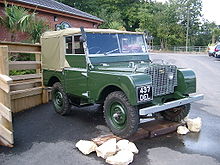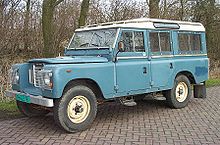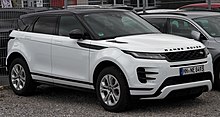Land Rover
| Land Rover | |
|---|---|

|
|
| Owner / user | Jaguar Land Rover |
| Introductory year | 1948 |
| Markets | Worldwide |
| Website | www.landrover.de |
| Land Rover | |
|---|---|
| legal form | Private Unlimited Company |
| founding | June 16, 2000 |
| Seat | Coventry |
| Branch | Automotive industry |

Land Rover is a brand of the British car manufacturer Jaguar Land Rover . It was created in 1978 from the Land Rover off-road vehicle series built by the manufacturer Rover from 1948 . The main plant is located in Solihull, England .
In 1966 Rover became part of the British Leyland government merger of British vehicle manufacturers . In 1978 Land Rover became a separate company within the Jaguar-Rover-Triumph group of companies.
In 1994 it was initially sold to the German automobile manufacturer BMW . From 2000 the company (together with Jaguar and Volvo and until the beginning of 2007 Aston Martin ) belonged to the Premier Automotive Group of the American Ford group, which sold it to the Indian Tata group in March 2008 .
In addition to the company, the vehicles, especially the successor to the original series , the Defender , but occasionally also the three other product lines Range Rover , Discovery and Freelander , are colloquially referred to as "Landy".
On December 28, 2012, the business of the Land Rover Private Unlimited Company was transferred to Jaguar Cars Limited and the name was changed to Jaguar Land Rover Limited . The Land Rover Private Unlimited Company continues to exist, the brand names will continue to operate separately.
History of the vehicle
The idea

In 1929, Spencer Bernau Wilks joined Rover as Managing Director. He brought his younger brother, engineer Maurice Wilks, into the company, who later launched the Land Rover SUV.
Immediately after the Second World War , the British government urgently needed foreign currency and began to put pressure on the automotive industry: cheaply produced mass and mass-produced cars were to be developed and exported around the world . Up until now, Rover had mainly produced luxury cars of high quality and high prestige - but hardly anyone could afford them after the war.
Maurice Wilks was technical director at the time. On his country estate he used a Willys Jeep , a legacy of the US armed forces. Wilks was convinced of the usefulness of the jeep, but the vehicle was already decrepit and rusty due to the damp climate. So he had the idea of building an agricultural off-road vehicle at Rover and thus leading the company out of the crisis.
The prototype was assembled on a Jeep chassis in just a few weeks in the spring of 1947 ; the name "Land-Rover" (a rover for agriculture) was used from the beginning and was later retained. The body panels were made of duralumin . In the same year, the Rover board gave the green light for a small series.
The first series

First a separate chassis was constructed. A ladder frame and a bulkhead made of steel form the stable basic structure. Since steel in the appropriate length was not available for the chassis , it was welded together from two pieces.
As with the prototype, duralumin was used for most of the other components . It was three times more expensive than steel, but much more available - most of the steel reserves were used up by the arms industry during the Second World War. It was a fortunate coincidence that the surface quality of aluminum changes, but does not rust deeply. The resulting longevity quickly became a Land Rover trademark. More than half of all “pre-production” Land Rovers (i.e. those that were produced before the production model came on the market) still exist today, also because the ladder frames were completely hot-dip galvanized . The other "Series One" were not galvanized and only sprayed with the body color. The first model, a vehicle with a wheelbase of 80 ", was powered by a Rover's own 1.6-liter engine, which was also used in a Rover car.
The first Land Rover was unveiled at the Amsterdam Motor Show on April 30, 1948. Up until this point, the Rover board was by no means sure whether the vehicle would find buyers or whether it was a bad investment. Far more orders were received than expected at this trade fair; this success continued. In the end, the Land Rover brought the company out of its crisis.
All Land-Rover vehicles from 1948 to 1958 are considered "Series I".
After 68 years and a production of over two million vehicles, the last Land Rover Defender left the production facilities in Solihull, UK, on January 29, 2016.
The successor models

In 1958, the already extremely successful Land Rover was technically revised and launched on the market as the "Series II". As a result of this introduction, all Land Rovers built up to then became Series I retrospectively. It was followed in 1971 by the "Series III" and in 1983 by the coil-sprung Land Rover 90 and 110, which was only named Defender in the early 1990s . The concept of a stable steel ladder frame chassis with a heavy box section and a steel bulkhead as the basis for the other parts as well as an aluminum body has been retained for all models to this day.
Due to the great demand, Rover began to have the Land Rover built under license in other countries from 1952. From 1953 to 1955, Hamburg-based Tempo GmbH produced 250 Land Rovers in modified form for the Federal Border Guard . The Belgian manufacturer Minerva produced around 18,000 Land Rovers with slightly modified bodies for the Belgian army between 1952 and 1956. The license replicas from Spain by Santana Motor are very well known . Between 1959 and 1994, almost 290,000 Land Rovers were built there. Until 2011, Santana produced largely independent SUVs with Iveco engines that were at least optically reminiscent of the Defender .
Although the "series" Land Rover differ from one another in appearance and technology, they all have the typical "Land Rover look": square, with a radiator grille set off from the wheel arches and round headlights.
Under pressure from the Japanese all-wheel drive vehicles Toyota Land Cruiser and Nissan Patrol , which conquered the European market, various innovations were introduced in the development of the 90 and 110 : power steering, permanent all-wheel drive , disc brakes instead of drum brakes at the front, coil springs instead of leaf springs. The chassis had to be completely redesigned, especially for the suspension. Many technical details were incorporated into the Range Rover at the time .
With the introduction of the 200tdi engine in the summer of 1990, the Land Rover 110 and 90 became the Land Rover Defender .
Expansion of the product range

From July 1970 Land Rover (then part of British Leyland) produced the luxury model Range Rover , a luxuriously equipped off-road vehicle with permanent all-wheel drive equipped with coil springs . The Range Rover expanded the market and the company's image.
The Discovery presented in October 1989 closes the gap in the middle price segment between the rustic Defender and the luxurious Range Rover.
The introduction of the Range Rover and the Discovery made it necessary to give the Land Rover series a name. Therefore, the further development of the classic Land Rover was now called Defender.
The Freelander, developed at the time under BMW management, has been available since the beginning of 1998 . It is a Sport Utility Vehicle (SUV).
Notation
The name Land Rover appeared in the first days of prototype development in 1947 and was retained. Until 1980 the name was spelled with a hyphen or in one word. Since 1980 the official spelling has been in two words without a hyphen.
When designating the Land Rover series models, the length is given as an Arabic number after it. This is the distance between the front and rear axles in inches. So there was the Land Rover Series III z. B. in two lengths: 88 and 109. In the Defender, the fourth series, the center distances were rounded - the Defender is available in three lengths 90, 110 and 130. However, the center distance of the 90 is 93 inches and that of the 130 to 127 inches. The 90s is also called "Ninety" and the 110s "One Ten".
The company and the world market

At the turn of the millennium, the Land Rover (Series I to Defender) had already sold well over 1.6 million copies.
In contrast to the Jeep and the Austin Champ , the Land Rover has its origins in civilian use. However, it was only a matter of time before the military became interested in the car. As early as 1950, the British Army ordered over 100 units, displacing the military version of the Austin Champ from the market, which cost almost twice as much as the Land Rover to manufacture. Some Land Rovers were used in the Korean War that same year. In 1956 the Land Rover officially became the standard vehicle for the British armed forces. The very successful model "Military Land-Rover" (colloquially known as "Lightweight") was z. B. developed as a pure military vehicle together with the British Army, it was not available for commercial use. An estimated 50% of all Land Rovers shipped went to the military or government agencies.
The Land Rover (Series I to Defender) has made its name primarily on trips and expeditions. Its simple and resilient construction as well as the simple and therefore reliable and easily repairable technology mean that this vehicle has been found for almost six decades in the Sahara and in other places where it is vital that people rely on their vehicle can.
Vehicle development, in particular the product expansion to include the Range Rover and the Discovery, brought about major upheavals for Rover:
- In 1983, 90 percent of all Land Rovers were exported to developing countries,
- In 1993, 90 percent of them were sold in the western world, where customers have different requirements for an off-road vehicle.
With the launch of the second and third generation Range Rover and Discovery, and the launch of the Freelander in 1997 (which was right at the top of the market when it was first introduced), Land Rover has strengthened its position in the 4 × 4 market worldwide .
In June 2007, the Financial Times reported that the US company Ford intends to sell its Jaguar and Land Rover subsidiaries through the investment banks Goldman Sachs, Morgan Stanley and HSBC. According to analysts, both divisions in the package should be worth the equivalent of 1.2 to 1.5 billion euros.
After Ford had invited Jaguar and Land Rover employee representatives to talks with potential buyers on November 20, 2007, Ford examined the buyers' offers in the second week of December.
The sale was completed in March 2008. The Indian automobile company Tata is the new owner . Tata is said to have made assurances for the preservation of the production sites and jobs in Great Britain. In addition, Tata has made binding statements on the preservation of the two brands Jaguar and Land Rover.
Models
Timeline
| Timeline of civil Land Rover models since 1945 | ||||||||||||||||||||||||||||||||||||||||||||||||||||||||||||||||||||||||||||
|---|---|---|---|---|---|---|---|---|---|---|---|---|---|---|---|---|---|---|---|---|---|---|---|---|---|---|---|---|---|---|---|---|---|---|---|---|---|---|---|---|---|---|---|---|---|---|---|---|---|---|---|---|---|---|---|---|---|---|---|---|---|---|---|---|---|---|---|---|---|---|---|---|---|---|---|---|
| Type \ vintage | rover | British Leyland | Rover Group | BMW | ford | Tata | ||||||||||||||||||||||||||||||||||||||||||||||||||||||||||||||||||||||
| 1940s | 1950s | 1960s | 1970s | 1980s | 1990s | 2000s | 2010s | 2020s | ||||||||||||||||||||||||||||||||||||||||||||||||||||||||||||||||||||
| 5 | 6th | 7th | 8th | 9 | 0 | 1 | 2 | 3 | 4th | 5 | 6th | 7th | 8th | 9 | 0 | 1 | 2 | 3 | 4th | 5 | 6th | 7th | 8th | 9 | 0 | 1 | 2 | 3 | 4th | 5 | 6th | 7th | 8th | 9 | 0 | 1 | 2 | 3 | 4th | 5 | 6th | 7th | 8th | 9 | 0 | 1 | 2 | 3 | 4th | 5 | 6th | 7th | 8th | 9 | 0 | 1 | 2 | 3 | 4th | 5 | 6th | 7th | 8th | 9 | 0 | 1 | 2 | 3 | 4th | 5 | 6th | 7th | 8th | 9 | 0 | |
| Off-road vehicle | Land Rover (Series I) | Land Rover (Series II) | Land Rover (Series III) | Land Rover 90/110 / Defender | Land Rover Defender | |||||||||||||||||||||||||||||||||||||||||||||||||||||||||||||||||||||||
| Range Rover Sport | Range Rover Sport | |||||||||||||||||||||||||||||||||||||||||||||||||||||||||||||||||||||||||||
| Discovery I. | Discovery II | Discovery 3 / LR3 | Discovery 4 / LR4 | Discovery V | ||||||||||||||||||||||||||||||||||||||||||||||||||||||||||||||||||||||||
| Range Rover I. | Range Rover II | Range Rover III | Range Rover IV | |||||||||||||||||||||||||||||||||||||||||||||||||||||||||||||||||||||||||
| SUV | Freelander I. | Freelander 2 / LR2 | Discovery Sport | |||||||||||||||||||||||||||||||||||||||||||||||||||||||||||||||||||||||||
| Range Rover Evoque I. | Range Rover Evoque II | |||||||||||||||||||||||||||||||||||||||||||||||||||||||||||||||||||||||||||
| Range Rover Velar | ||||||||||||||||||||||||||||||||||||||||||||||||||||||||||||||||||||||||||||
Civil models


- Land Rover Series I (1948-1958)
- Land Rover Series II (1958-1971)
- Land Rover Series III (and Stage One; 1971–1984)
- Land Rover Defender (90, 110, 130; 1983-2016)
- Land Rover Defender (L663) (from 2020)
- Land Rover Discovery (since 1989)
- Land Rover Freelander (1998-2014)
- Land Rover Discovery Sport (since 2015)
- Range Rover (since 1970)
- Range Rover Evoque (2011-2018)
- Range Rover Velar (since 2017)
- Range Rover Sport (since 2005)
- Range Rover Evoque II (since 2019)
Military models
- Land Rover Perentie
- Land Rover Forward Control (109/110)
- Land Rover Lightweight (mil)
- Land Rover 101 FC (mil)
- Land Rover Llama
literature
- Pat Ware: The Quarter ton Utility in British Military Service 1941-1958: Ford & Willys Jeep, Austin Champ, Land Rover series 1. Verlag Warehouse, 1996, ISBN 0-9525563-2-4 . (English)
- Matthias Pfannmüller, Boris Schmidt: Land Rover 1948 until today. 5th edition. Delius Klasing, Bielefeld 2011, ISBN 978-3-7688-3374-5 .
Web links
- Land Rover International
- Land Rover Germany
- Special versions of the Land Rover Defender (photo report by Heise)
Individual evidence
- ↑ a b c Excerpt from the British Commercial Register
- ^ Spiegel Online of March 26, 2008
- ↑ Financial Times Deutschland Online ( memento from August 1, 2012 in the web archive archive.today ) from March 26, 2008
- ↑ http://data.companieshouse.gov.uk/doc/company/04019301
- Jump up ↑ Enterprise Today: Land Rover Defender: The Final Farewell. Retrieved May 23, 2016.
- ↑ News from the international automotive industry. In: Motor vehicle technology 12/1958, p. 458
- ^ Matthias Pfannmüller: Land Rover type compass. Off-road vehicle since 1948. 2nd edition. Motorbuch-Verlag, Stuttgart 1999, ISBN 3-613-01982-5 .
- ↑ Ford sells traditional brands - last exit Bombay ( Memento from December 10, 2008 in the Internet Archive ) sueddeutsche.de from January 4, 2008

